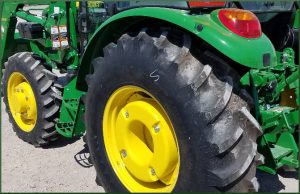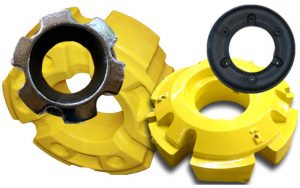Tractor Weights For Loader Equipped Tractors
Common Questions and Considerations
If you need more information or to discuss your particular equipment and application, please contact us.
CAUTION: To avoid personal injury or death from tractor/loader rollover, add recommended ballast to rear wheels or to rear hitch.
Depending upon ground speed, loader loads and operating terrain, minimum ballast recommendation as stated in your Operator's Manual, may not be adequate or may need to be increased.
Introduction
Our Experience
We daily get calls from the owners of tractors with front loaders attached. It is almost always the same scenarios. Their tractor feels light in the rear, feels unstable, or does not have traction in the rear of the tractor when using the loader. Many owners of MFWD tractors say they must have the front wheel drive engaged to even move the tractor when operating the loader. As tractors have become lighter overall, horsepower has increased, and the performance of loaders has become extraordinary, we have experienced a dramatic increase in the need for proper ballasting of these tractors.
With typical tractor loaders capable, depending on model, of lifting anywhere from 500 pounds to over 5,000 pounds, correct ballasting is very important for the safe and efficient operation of these tractors.
We routinely provide information and products to successfully eliminate many of the ballast problems associated with the use of front loaders. If you need more information, please contact us.
Using Front Tractor Weights With Loader Attached.
Front Weights and Loaders
Typically, front mounted suitcase or front mounted slab weights are not used with loaders attached. The weights will interfere with the operation of the loader and can easily overload the front of the tractor during normal operation. If you believe you really require additional front weight when operating a loader, please contact us for more information.
Fluid In Tractor Tires As Ballast
Loaded Tires
For information about using fluid in your tractor tire wheels for additional weight, please see our FAQ at the button below.
Sub-Compact Tractors With Loaders.
Sub Compact Tractors and Loaders
Typical Lifting Capacities 500-900 pounds. Depending on Model.
Improved handling during loader operation can often be achieved on these models with rear ballast. Options include rear wheel weights, rear weight brackets, Heavy Hitch®type products, rock boxes, or even the installation of another of your implements on the rear of your machine.
Adding another implement to the rear usually makes for a longer and less nimble situation. Heavy Hitch® type products are designed to install on the rear hitch and can usually be easily added or removed as the situation warrants. Tractor wheel weights, while removable, usually are not removed once installed by most owners. We will be happy to make a recommendation once we know the model of your equipment and your intended usage. Simply contact us for more information.
It is important to note that some of these tractors do not have full length frames and in some circumstances the transmission case acts as a part of the frame. Overloading the rear of the tractor and subsequently using the loader to maximum capability can cause unreasonable stress and result in an expensive repair. Always follow the manufacturer's guidelines for ballasting your model.
Compact Tractors With Loaders.
Compact Tractors and Loaders
Typical Lifting Capacities 500-2700 Pounds. Depending on Model.
Like all tractors with loaders, compact tractor owners will usually see improved handling with the addition of rear weight. Here also, rear wheel weights, Heavy Hitch® type products, rock boxes, etc. are all viable options.
We find that most of these owners eventually choose wheel weights as their best option. Due to a variety of wheel sizes, mounting hole patterns and wheel widths, it is important to contact us before making a decision on purchasing wheel weights. Some of these models with the wider wheels require adapters to mount the wheel weights.
It is important to note that some of these tractors do not have full length frames and in some circumstances the transmission case acts as a part of the frame. Overloading the rear of the tractor and subsequently using the loader to maximum capability can cause unreasonable stress and result in an expensive repair. Always follow the manufacturer's guidelines for ballasting your model.
Utility Tractors With Loaders.
Utility Tractors and Loaders
Typical Lifting Capacities 2500-5000+ Pounds. Depending on Model.
These are the tractors where we receive the most questions regarding the addition of rear ballast. Utility tractors encompass a wide variety of machines and can be ordered or set up in many configurations.
The vast majority of these tractors with front loaders are ballasted either with rear wheel weights or fluid loaded tires. It is our experience that most of these owners will ultimately choose rear wheel weights for their tractors.
When ballasting, it is always best to consider the manufacturers recommendation. Due to the wide variety of wheel sizes, horsepower, and overall tractor size, it is usually best to contact us to discuss your machine and your application. We have more than a few solutions for these models and want to make sure you understand the pros and cons of each option.
Some of the factory type weights, installed or stacked to the manufacturers recommendation, will extend out from the wheel and cause operational and handling issues. We have specialty weights for 28" or larger wheels that will not extend beyond the edge of the tire and will not exceed the manufacturers recommendations for maximum ballast.
We often hear that the prospective buyer is looking for the maximum weight that can be bolted to their machine. This is rarely the optimal decision. We encourage you to contact us to learn more about all the available options and the best practices for your application.
See our FAQ on Loaded Tires (Fluid Filled) Tires for More Information.

Row Crop Tractors With Loaders.
Row Crop Tractors and Loaders
Typical Lifting Capacities 4000+ Pounds. Depending on Model.
Owner's of row crop tractors should follow the manufacturers guidelines for wheel weight ballast or for fluid ballast.
These tractors can use very heavy weights often in multiple combinations. We offer some of the most competitive pricing available in the marketplace for both factory style weights and specialty weights.
Due to the wide variety of possible options, we encourage you to contact us to discuss your equipment and application.

